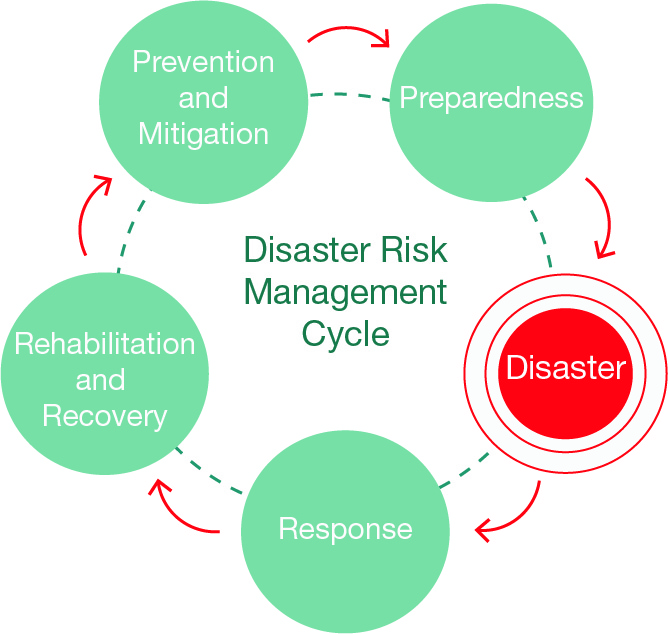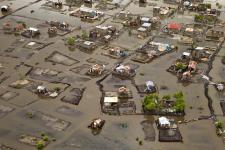Who are the users of space technology in disaster risk management and disaster response? What is the context of their daily work? What are their needs and challenges? The Risks and Disasters section seeks to shed light on these issues.
As stated by the United Nations Office for Disaster Risk Reduction (UNDRR), a disaster can be defined as "a serious disruption of the functioning of a community or society involving widespread human, material, economic or environmental losses and impacts, which exceeds the ability of the affected community or society to cope with using its own resources." In the last few decades, societies have become increasingly aware of the fact that disasters can be analysed as the result of long-term processes; whereby the risk is created years or decades before the disaster manifests itself.
Risks represent the presence of vulnerable elements in areas exposed to hazards. For over a decade, UNDRR and other regional and international organizations have reported that such risks arise due to underlying risk drivers; such as unequal economic development, poorly planned/managed urban and regional development, the decline of regulatory ecosystem services, poverty and inequality, weak governance, and weak local capacities.
This section contains information on the basic definitions and processes related to disaster-risk management; as well as terminology related to emergency and disaster management, and the role of the UN in these areas.
Disaster Risk Management
According to UNDRR, disaster-risk management is the systematic process of using administrative directives, organizations, and operational skills/capacities to implement strategies, policies and improved coping capacities; in order to lessen the adverse impacts of hazards, and the possibility of disaster. When successful, disaster-risk management efforts aim to reduce the effects of hazards, through activities and measures related to prevention, mitigation, and preparedness.

Emergency and Disaster Management
According to UNDRR, disaster management focuses on the organization and management of resources and responsibilities to address all aspects of emergencies and disasters; including preparedness, response and initial recovery steps. While emergencies are events that can be managed with local resources, disasters are by definition those events that surpass the responders capacity on the ground to manage them locally, hence requiring external assistance to be managed. Emergency and disaster management encompass three types of phases: response, rehabilitation and recovery. While response and rehabilitation efforts are conducted in the days and weeks following the onset of the disaster, recovery efforts are conducted in the months and years after the onset and include reconstruction of infrastructure and the restoration of livelihoods.
Natural Hazards
Natural hazards are defined by UNDRR as natural processes or phenomena that may cause loss of life, injury or other health impacts, property damage, loss of livelihoods and services, social and economic disruption, or environmental damage. Natural hazards can be characterized by their magnitude or intensity, speed of onset, duration, and area of extent. This section offers a summary of the characteristics, impacts, damage types, emergency actions, mitigation, and further measures, associated with the different types of natural hazards.
The UN and Disaster Risk Management
Since the early 1990s, the United Nations have been promoting efforts worldwide to advocate the implementation of policies and measures aiming to reduce risks before such risks evolve into disasters when sudden-onset events like earthquakes and slow-onset events like droughts impact vulnerable communities. The current framework for disaster-risk reduction is called the Sendai Framework for Disaster Risk Reduction and outlines four Key Priority Areas that encompass all aspects of disaster risk reduction in a coherent way. This framework was launched during the Third World Conference on Disaster Risk Reduction, which was held in Sendai, Japan from 14 to 18 March 2015. It paves the way for governments and societies to implement concrete measures to avoid the creation of new risks, reduce the level of existing risks and strengthen the economic and social resilience of communities by addressing the exposure and vulnerability of people and their assets.
The UN and Disaster Management
Since the early 1970s, the United Nations have been providing humanitarian assistance to countries affected by disasters which have requested such assistance officially. As a way to provide such support in a more timely and efficient way, the United Nations Office for the Coordination of Humanitarian Affairs (OCHA) has established a structured approach that includes the provision of initial technical assistance through the United Nations Disaster Assessment and Coordination teams (UNDAC); the establishment of On-Site Operations Coordination Centres (OSOCC) when necessary; and through the OCHA clusters.

